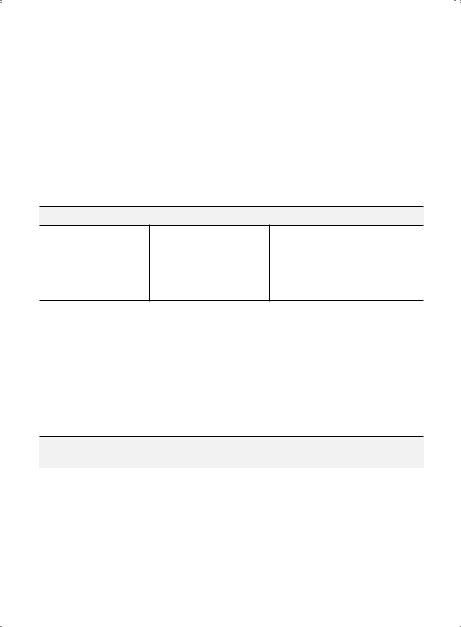
- •Abbreviations
- •1 Overview of Antimicrobial Therapy
- •Factors in Antibiotic Selection
- •Factors in Antibiotic Dosing
- •Microbiology and Susceptibility Testing
- •PK/PD and Other Considerations in Antimicrobial Therapy
- •Antibiotic Failure
- •Pitfalls in Antibiotic Prescribing
- •References and Suggested Readings
- •2 Empiric Therapy Based on Clinical Syndrome
- •Empiric Therapy of CNS Infections
- •Empiric Therapy of HEENT Infections
- •Empiric Therapy of Lower Respiratory Tract Infections
- •Empiric Therapy of GI Tract Infections
- •Empiric Therapy of Genitourinary Tract Infections
- •Empiric Therapy of Sexually Transmitted Diseases
- •Empiric Therapy of Bone and Joint Infections
- •Empiric Therapy of Skin and Soft Tissue Infections
- •Sepsis/Septic Shock
- •Febrile Neutropenia
- •Transplant Infections
- •Toxin-Mediated Infectious Diseases
- •Bioterrorist Agents
- •References and Suggested Readings
- •Gram Stain Characteristics of Isolates
- •Parasites, Fungi, Unusual Organisms in Blood
- •Parasites, Fungi, Unusual Organisms in CSF/Brain
- •Parasites, Fungi, Unusual Organisms in Lungs
- •Parasites, Fungi, Unusual Organisms in Heart
- •Parasites, Fungi, Unusual Organisms in the Liver
- •References and Suggested Readings
- •5 HIV Infection
- •HIV Infection Overview
- •Stages of HIV Infection
- •Acute (Primary) HIV Infection
- •Initial Assessment of HIV Infection
- •Indications for Treatment of HIV Infection
- •Antiretroviral Treatment
- •Treatment of Other Opportunistic Infections in HIV
- •HIV Coinfections (HBV/HCV)
- •References and Suggested Readings
- •6 Prophylaxis and Immunizations
- •Surgical Prophylaxis
- •Post-Exposure Prophylaxis
- •Chronic Medical Prophylaxis
- •Endocarditis Prophylaxis
- •Travel Prophylaxis
- •Tetanus Prophylaxis
- •Immunizations
- •References and Suggested Readings
- •Empiric Therapy of CNS Infections
- •Empiric Therapy of HEENT Infections
- •Empiric Therapy of Lower Respiratory Tract Infections
- •Empiric Therapy of Vascular Infections
- •Empiric Therapy of Gastrointestinal Infections
- •Empiric Therapy of Bone and Joint Infections
- •Empiric Therapy of Skin and Soft Tissue Infections
- •Common Pediatric Antimicrobial Drugs
- •References and Suggested Readings
- •8 Chest X-Ray Atlas
- •References and Suggested Readings
- •9 Infectious Disease Differential Diagnosis
- •11 Antimicrobial Drug Summaries
- •Appendix
- •Malaria in Adults (United States)
- •Malaria in Children (United States)
- •Index

84 |
A n t i b i o t i c E s s e n t i a l s |
Therapeutic Considerations: Graft must be removed for cure.. Operate as soon as diagnosis is confirmed (no value in waiting for surgery).. MRSA is a rare cause of AV graft infection; if present, treat with linezolid 600 mg (IV or PO) q12h until graft is replaced..
Prognosis: Good if infected graft is removed before septic complications develop..
Empiric Therapy of GI Tract Infections
Esophagitis
|
Usual |
Preferred IV |
Alternate IV |
PO Therapy or |
Subset |
Pathogens |
Therapy |
Therapy |
IV-to-PO Switch |
|
|
|
|
|
Fungal |
Candida |
Fluconazole |
Micafungin 150 mg (IV) q24h |
Fluconazole 200 mg |
|
albicans |
200 mg (IV or |
× 2–3 weeks or Caspofungin |
(PO) × 1 dose, then |
|
|
PO) × 1 dose, |
50 mg (IV) q24h × 2–3 |
100 mg (PO) q24h |
|
|
then 100 mg |
weeks or Anidulafungin |
× 2–3 weeks* or |
|
|
(IV or PO) q24h |
100 mg (IV or PO) × 1 dose |
Posaconazole 100 |
|
|
× 2–3 weeks |
then 50 mg (IV) q24h × 2–3 |
mg (PO)q12h × 1 day, |
|
|
|
weeks or Amphotericin B |
then 100 mg (PO) |
|
|
|
deoxycholate 0..5 mg/kg |
q24h × 2 weeks or |
|
|
|
(IV) q24h × 2–3 weeks or |
Itraconazole 200 mg |
|
|
|
Itraconazole 200 mg (IV) |
(PO) solution q24h × |
|
|
|
q12h × 2 days, then 200 mg |
2–3 weeks |
|
|
|
(IV) q24 h × 2–3 weeks |
|
|
|
|
|
|
Viral |
HSV-1 |
Acyclovir 5 |
Valacyclovir 500 mg (PO) q12h × 3 weeks or |
|
|
|
mg/kg (IV) q8h |
Famciclovir 500 mg (PO) q12h × 3 weeks |
|
|
|
× 3 weeks |
|
|
|
|
|
|
|
|
CMV |
Ganciclovir |
Valganciclovir 900 mg (PO) q12h × 3 weeks |
|
|
|
5 mg/kg (IV) |
|
|
|
|
q12h × 3 |
|
|
|
|
weeks |
|
|
|
|
|
|
|
Duration of therapy represents total time IV, PO, or IV + PO.. Most patients on IV therapy able to take PO meds should be switched to PO therapy soon after clinical improvement (usually < 72 hours)..
*Loading dose is not needed PO if given IV with the same drug..
Clinical Presentation: Pain on swallowing..
Diagnosis: Stain/culture for fungi/HSV/CMV on biopsy specimen..
Fungal (Candida) Esophagitis
Diagnostic Considerations: Rarely if ever in normal hosts.. Often (but not always) associated with Candida in mouth.. If patient is not alcoholic or diabetic and is not receiving antibiotics, test for HIV.. Pitfalls: Therapy as a diagnostic trial is appropriate.. Suspect CMV-related disease and proceed to endoscopy if a patient with a typical symptom complex fails to respond to antifungal therapy..

Chapter 2. Empiric Therapy Based on Clinical Syndrome |
85 |
Therapeutic Considerations: In normal hosts, treat for 1 week after clinical resolution.. HIV patients respond more slowly than normal hosts and may need higher doses/treatment for 2–3 weeks after clinical resolution (see p.. 336)..
Prognosis: Related to degree of immunosuppression..
Viral Esophagitis
Diagnostic Considerations: Rarely in normal hosts.. May occur in the immunosuppressed.. Pitfalls: Viral and non-viral esophageal ulcers look similar; need biopsy for specific viral diagnosis..
Therapeutic Considerations: In normal hosts, treat for 2–3 weeks after clinical resolution. . HIV patients respond more slowly and may need treatment for weeks after clinical resolution..
Prognosis: Related to degree of immunosuppression..
Peptic Ulcer Disease (H. pylori)
Triple Therapy |
Quadruple Therapy |
Sequential Therapy |
PPI + amoxicillin 1 gm (PO) q12h plus either clarithromycin 500 mg (PO) q12h or tinidazole (or metronidazole) 500 mg (PO) q12h all × 2 weeks
PPI + metronidazole 500 mg (PO) q12h + doxycycline 100 mg (PO) q12h + bismuth subsalicylate 525 mg tabs (PO) q6h all × 2 weeks
5 days: PPI + amoxicillin 1 gm (PO) q12h; next 5 days: PPI plus either clarithromycin 500 (PO) q12h or levofloxacin 500 mg (PO) q24h
Diagnostic Considerations: Invasive: rapid urease test, histology, culture. . Noninvasive: serum ELISA test, urea breath test, stool (monoclonal antibody) antigen test..
Pitfalls: False negative H. pylori tests with antibiotics, bismuth, PPIs.
Therapeutic Considerations: See above grid.. Therapeutic failure: substitute bismuth (for amoxicillin) or substitute nitazoxanide 1 gm (PO) q12h (for clarithromycin, metronidazole or tinidazole) all × 2 weeks.. 1 week of therapy often fails.
Tests of Cure: Urea breath test → 4–6 weeks post-therapy.. Stool antigen test → 6–8 weeks post-ther- apy.. Stop PPIs 2 weeks before re-testing..
Gastric Perforation
|
Usual |
Preferred |
Alternate |
|
Subset |
Pathogens |
IV Therapy |
IV Therapy |
IV-to-PO Switch |
|
|
|
|
|
Gastric |
Oral |
Cefazolin |
Any beta- |
Amoxicillin 1 gm (PO) q8h × 1–3 days or |
perforation |
anaerobes |
1 gm (IV) |
lactam (IV) |
Cephalexin 500 mg (PO) q6h × 1–3 days |
|
|
q8h × 1–3 |
× 1–3 days |
or Quinolone* (PO) q24h × 1–3 days |
|
|
days |
|
|
|
|
|
|
|
*Levofloxacin 500 mg or Moxifloxacin 400 mg..
Clinical Presentation: Presents acutely with fever and peritonitis..
Diagnostic Considerations: Obtain CT/MRI of abdomen for perforation/fluid collection.. Pitfalls: No need to cover B.. fragilis with perforation of stomach/small intestine.. Therapeutic Considerations: Obtain surgical consult for possible repair..
Prognosis: Good if repaired..

86 A n t i b i o t i c E s s e n t i a l s
Infectious Diarrhea/Typhoid (Enteric) Fever
|
Usual |
|
|
Subset |
Pathogens |
Preferred Therapy |
Alternate Therapy |
|
|
|
|
Acute watery |
E.. coli (ETEC, EHEC) |
Quinolone† (IV or PO) × |
Doxycycline 100 mg |
diarrhea |
Campylobacter |
5 days |
(IV or PO) q12h × 5 days |
|
Yersinia Salmonella |
|
or |
|
Vibrio sp.. |
|
TMP–SMX 1 DS tablet (PO) |
|
|
|
q12h × 5 days |
|
|
|
|
C.. difficile |
Clostridium difficile |
Diarrhea †§ |
Diarrhea |
diarrhea/ |
|
Initial episode: |
Initial episode: |
colitis |
|
Vancomycin 250 mg (PO) |
Nitazoxanide 500 mg (PO) |
|
|
q6h × 7–10 days* (If no |
q12h × 7–10 days |
|
|
improvement in 3 days, ↑ |
or |
|
|
dose to 500 mg (PO) q6h × |
Metronidazole 250 mg (PO) |
|
|
7 days)** |
q6h × 7–10 days* |
|
|
Relapse: |
Relapse: |
|
|
Vancomycin 500 mg (PO) |
Nitazoxanide 500 mg (PO) |
|
|
q6h × 14 days** |
q12h × 7–10 days |
|
|
Recurrence:†† |
Recurrence: |
|
|
Vancomycin 500 mg (PO) |
Nitazoxanide 500 mg (PO) |
|
|
q6h ×1 month (do not |
q12h × 7–10 days |
|
|
taper vancomycin dose). |
or |
|
|
If another recurrence, re- |
Rifaximin 400 mg (PO) q8h |
|
|
treat with Vancomycin 500 |
× 10 days |
|
|
mg (PO) q6h ×2 months.. |
or |
|
|
Ifanother recurrence, re- |
Fidoxamicin 200 mg (PO) |
|
|
treat with Vancomycin 500 |
q12h × 10 days |
|
|
mg (PO) q6h ×3 months.. |
|
|
|
If dose not tapered and if |
|
|
|
no colitis, this regimen |
|
|
|
will not fail! If diarrhea |
|
|
|
continues, rule out C.. |
|
|
|
difficile colitis or look for |
|
|
|
alternate diagnosis.. |
|
*Treatment failure common with Vancomycin 125 mg (PO) q6h and with Metronidazole at any dose, (Flagyl frequently fails!).
**If no improvement after 3 days with Vancomycin 500 mg (PO) q6h, rule out colitis with abdominal CT scan. If abdominal CT scan shows colitis treat as C.. difficile colitis.
†When treating C.. difficile diarrhea or colitis, discontinue antibiotics with a high C. difficile potential, e..g.., cilndamycin, ciprofloxacin, α-lactams (excluding ceftriaxone)..
Patients being treated with levofloxacin or moxifloxacin should not concurrently be taking PPIs.. Either discontinue PPI or switch to a H2 blocker during quinolone therapy..
†† Avoid C. difficile “prophylaxis.“ Do not treat “history of C. difficile.” Instead, repeat C. difficile stool PCR to verify diagnosis.. Treat C.. difficile diarrhea only if PCR + for C.. difficile..
§ Avoid anti-spasmatics in C. difficile diarrhea; use may result in C.. difficile colitis.
§§ Colectomy may be lifesaving in severe C.. difficile pancolitis..

Chapter 2. Empiric Therapy Based on Clinical Syndrome |
87 |
Infectious Diarrhea/Typhoid (Enteric) Fever (cont’d)
|
Usual |
|
|
Subset |
Pathogens |
Preferred Therapy |
Alternate Therapy |
|
|
|
|
|
|
Colitis |
Colitis |
|
|
Initial episode: |
Initial Episode: |
|
|
Metronidazole 1 gm (IV) |
Metronidazole 250 mg (PO) |
|
|
q24h until cured |
q6h until cured |
|
|
plus |
plus |
|
|
Ertapenem 1 gm (IV) 124h |
Tigecycline 200 mg (IV) × 1 |
|
|
(until associated peritonitis |
dose, then 100 mg (IV) q24h |
|
|
component resolves) |
until cured |
|
|
|
or |
|
|
|
Nitazoxanide 500 mg (PO) |
|
|
|
q12h until cured |
|
|
Severe Pancolitis:§§ |
|
|
|
Metronidazole 500 mg |
|
|
|
(IV/PO) q6h–8h until cured |
|
|
|
plus |
|
|
|
Nitazoxanide 500 mg (PO) |
|
|
|
q12h × until cured |
|
|
|
plus |
|
|
|
Tigecycline 200 mg (IV) × |
|
|
|
1 dose, then, 100 mg (IV) |
|
|
|
q24h until cured |
|
|
|
Relapse or Recurrence: |
Relapse or Recurrence: |
|
|
Re-treat with |
Nitazoxanide 500 mg (PO) |
|
|
Metronidazole 500 mg (IV/ |
q12h until cured |
|
|
PO) q6–8h until cured |
|
|
|
|
|
Cytomegalo- |
CMV |
Valganciclovir 900 mg (PO) q12h × 21 days; for HIV, see p.. |
|
virus colitis |
|
334 |
|
|
|
|
|
§Colectomy may be lifesaving in severe C.. difficile pancolitis..

88 A n t i b i o t i c E s s e n t i a l s
Infectious Diarrhea/Typhoid (Enteric) Fever (cont’d)
|
Usual |
|
|
Subset |
Pathogens |
Preferred Therapy |
Alternate Therapy |
|
|
|
|
Typhoid |
Salmonella typhi/ |
Quinolone† (IV or PO) × |
Chloramphenicol 500 mg |
(enteric) fever |
paratyphi |
10–14 days |
(IV or PO) q6h × 10–14 days |
|
|
or |
or |
|
|
TMP–SMX 5 mg/kg (IV or |
any 3rd gen cephalosporin (IV |
|
|
PO) q6h × 10–14 days |
or PO) × 10–14 days |
|
|
|
or |
|
|
|
Azithromycin 1 gm (PO) |
|
|
|
q24h × 5 days |
|
|
|
|
Chronic |
Giardia lamblia* |
Tinidazole 2 gm (PO) × |
Albendazole 400 mg (PO) |
watery |
|
1 dose |
q24h × 5 days |
diarrhea |
|
or |
or |
|
|
Nitazoxanide 500 mg (PO) |
Quinacrine 100 mg (PO) q8h |
|
|
q12h × 3 days |
× 5 days |
|
|
or |
|
|
|
Metronidazole 2 gm (PO) |
|
|
|
q24h × 3 days |
|
|
|
|
|
|
Cryptosporidia* |
Nitazoxanide 500 mg (PO) |
Paromomycin 500–750 mg |
|
|
q12h × 5 days§ |
(PO) q8h until response |
|
|
|
or |
|
|
|
Azithromycin 600 mg (PO) |
|
|
|
q24h × 4 weeks |
|
|
|
|
|
Isospora* |
TMP–SMX 1 DS tablet (PO) q12h × 10 days‡ |
|
|
Cyclospora* |
|
|
Acute |
Entamoeba |
Preferred therapy: Metronidazole 750 mg (PO) q8h |
|
dysentery |
histolytica |
× 10 days followed by either Iodoquinol 650 mg (PO) |
|
|
|
q8h × 20 days or Paromomycin 500 mg (PO) q8h × 7 days |
|
|
|
Alternate therapy: Tinidazole 1 gm (PO) q12h × 3 days |
|
|
|
|
|
|
Shigella |
Quinolone† (IV or PO) |
TMP–SMX 1 DS tablet (PO) |
|
|
× 3 days |
q12h × 3 days |
|
|
|
or |
|
|
|
Azithromycin 500 mg (IV or |
|
|
|
PO) q24h × 3 days |
|
|
|
|
Duration of therapy represents total time IV, PO, or IV + PO.. Most patients on IV therapy able to take PO meds should be switched to PO therapy soon after clinical improvement (usually < 72 hours)..
*May also present as acute watery diarrhea..
†Ciprofloxacin 400 mg (IV) or 500 mg (PO) q12h or Levofloxacin 500 mg (IV or PO) q24h or Moxifloxacin 400 mg (IV or PO) q24h..
§Longer duration of therapy may be needed in immunosuppressed patients (treat until cured)..

Chapter 2. Empiric Therapy Based on Clinical Syndrome |
89 |
Acute Watery Diarrhea
Clinical Presentation: Acute onset of watery diarrhea without blood/mucus.. Diagnostic Considerations: Diagnosis by culture of organism from stool specimens..
Pitfalls: Recommended antibiotics are active against most susceptible enterotoxigenic bacterial pathogens causing diarrhea, but not viruses/parasites. . Concomitant transient lactase deficiency may prolong diarrhea if dairy products are taken during an infectious diarrhea..
Therapeutic Considerations: Avoid norfloxacin and ciprofloxacin due to resistance potential. . V.. cholerae may be treated with a single dose of any oral respiratory quinolone or doxycycline.. Prognosis: Excellent.. Most recover with supportive treatment..
Clostridium difficile Diarrhea/Colitis
Clinical Presentation: Voluminous watery diarrhea following exposure to C. . difficile contaminated fomites, exposure to patients with C.. difficile, recent cancer chemotherapy or antibiotic therapy with some, but not most, antibiotics.. Most often associated with clindamycin, ciprofloxacin, and b-lactams (excluding ceftriaxone)..
Diagnostic Considerations: Watery diarrhea with positive C.. difficile stool toxin.. A single positive PCR C.. difficile stool toxin test is sufficiently sensitive/specific for diagnosis (endpoint is end of diarrhea, not stool toxin negativity); If negative, no need to retest.. If C.. difficile colitis suspected in C.. difficile positive patients with fever/prominent leukocytosis/abdominal pain, confirm diagnosis by abdominal CT scan..
Pitfalls: C.. difficile colitis is suggested by the presence of otherwise unexplained leukocytosis, ↑ESR, abdominal pain and often temperature > 102°F; confirm diagnosis with CT/MRI of abdomen.. Virulent strains of C.. difficile may present with colitis with temperature ≤ 102°F, leukocytosis (often very high, i..e.., 25–50 K/mm3), and little/no abdominal pain; confirm diagnosis with CT/MRI of abdomen.. Radiographically C.. difficile colitis typically is a pancolitis.. Segmental colitis suggests a non-C.. difficile etiology, i..e.., ischemic colitis.. C.. difficile toxin test may remain positive in stools following resolution of diarrhea; In patients receiving enteral feeds, diarrhea is likely due to enteral feeds (high infusion rates/high osmotic loads) rather than C.. difficile.. Norovirus diarrhea may mimic C.. difficile diarrhea or concurrent outbreaks may occur.. Vancomycin may be ineffective in C.. difficile colitis..
Therapeutic Considerations: For C. difficile diarrhea oral vancomycin or nitazoxanide are preferred; Flagyl frequently fails. Rifaxamin and Fidaxomycin have no advantage over vancomycin. . With effective therapy, C.. difficile diarrhea begins to improve (≤ 3 days) and usually resolves by 5–7 days, although some patients require 10 days of therapy. . If no improvement with vancomycin 250 mg (PO) q6h, ↑ dose to 500 mg (PO) q6h or use nitazoxanide. . Do not treat C. difficile negative diarrhea with oral vancomycin or metronidazole. . For C. difficle colitis, treat until colitis resolves (follow with serial ESRs/abdominal and or CT scans).. Add aerobic GNB coverage for microscopic/gross peritonitis with ESRs ertapenem. . Tigecycline highly effective monotherapy for C. . difficle colitis; and also provides anti-B fragilis coverage (for associated microscopic/clinical peritonitis). . Avoid anti-motility agents, e.g., loperamide with C. difficile diarrhea which may result in C. difficile colitis/toxic megacolon.
Prognosis: Prognosis with C.. difficile diarrhea is excellent.. C.. difficile colitis prognosis is related to strain virulence/and extent of the colitis..
Typhoid (Enteric) Fever (Salmonella typhi/Paratyphi)
Clinical Presentation: High fevers (> 102°F) increasing in a stepwise fashion accompanied by relative bradycardia (without chills) with watery diarrhea/constipation, headache, anorexia, abdominal pain, dry cough/ sore throat, tender hepatomegaly, ±Rose spots.. Dull mental affect (“apathetic facies”) peculiar to typhoid fever.. Thrombocytopenia should suggest another diagnosis.. e..g.. malaria or viral coinfection, e..g.. dengue..

90 |
A n t i b i o t i c E s s e n t i a l s |
Diagnostic Considerations: Most community-acquired watery diarrheas are not accompanied by temperatures > 102°F and relative bradycardia.. Diagnosis is confirmed by demonstrating Salmonella in blood, bone marrow, Rose spots, or stool cultures.. Culture of bone marrow is the quickest/most reliable method of diagnosis.. WBC count is usually low/low normal.. Leukocytosis should suggest another diagnosis or bowel perforation, which may occur during 2nd week of typhoid fever.. Eosinopenia characteristic of typhoid/enteric fever.. In patients with suspected typhoid fever, eosinophilia should suggest an alternate diagnosis or parasitic coinfection..
Pitfalls: Rose spots are few/difficult to see and not present in all cases.. Typhoid fever usually presents with constipation, not diarrhea.. Severe rigors not a feature of typhoid fever..
Therapeutic Considerations: 2nd generation cephalosporins, aztreonam, and aminoglycosides are ineffective.. Since Salmonella strains causing enteric fever are intracellular pathogens, treat for a full 2 weeks to maximize cure rates/minimize relapses.. Treat relapses with the suggested antibiotics × 2–3 weeks.. Salmonella excretion into feces usually persists < 3 months.. Persistent excretion > 3 months suggests a carrier state—rule out hepatobiliary/urinary calculi..
Prognosis: Good if treated early.. Poor with late treatment/bowel perforation..
Chronic Watery Diarrhea
Clinical Presentation: Watery diarrhea without blood/mucus lasting > 1 month..
Diagnostic Considerations: Diagnosis by demonstrating organisms/cysts in stool specimens. . Multiple fresh daily stool samples often needed for diagnosis especially for protozoan parasites..
Pitfalls: Concomitant transient lactase deficiency may prolong diarrhea if dairy products are consumed during an infectious diarrhea..
Therapeutic Considerations: Cryptosporidia and Isospora are being recognized increasingly in acute/chronic diarrhea in normal hosts..
Prognosis: Excellent in well-nourished patients.. Untreated patients may develop malabsorption..
Giardia lamblia
Clinical Presentation: Acute/subacute onset of diarrhea, abdominal cramps, bloating, flatulence. . Incubation period 1–2 weeks.. Malabsorption may occur in chronic cases.. No eosinophilia..
Diagnostic Considerations: Diagnosis by demonstrating trophozoites or cysts in stool/antigen detection assay.. If stool exam and antigen test are negative and Giardiasis is suspected, perform “string test”/ duodenal aspirate and biopsy..
Pitfalls: Cysts intermittently excreted into stool.. Usually need multiple stool samples for diagnosis.. Often accompanied by transient lactose intolerance..
Therapeutic Considerations: Nitazoxanide effective therapy. . Diarrhea may be prolonged if milk (lactose-containing) products are ingested after treatment/cure.. May need repeat courses of therapy .. Prognosis: Related to severity of malabsorption and health of host..
Cryptosporidia
Clinical Presentation: Acute/subacute onset of diarrhea. . Usually occurs in HIV patients with CD4 counts < 200.. Biliary cryptosporidiosis is seen only in HIV; may present as acalculous cholecystitis or sclerosing cholangitis with RUQ pain, fever, ↑ alkaline phosphatase, but bilirubin is normal..
Diagnostic Considerations: Diagnosis by demonstrating organism in stool/intestinal biopsy specimen.. Cholera-like illness in normal hosts.. Chronic watery diarrhea in compromised hosts..
Pitfalls: Smaller than Cyclospora.. Oocyst walls are smooth (not wrinkled) on acid fast staining.. Therapeutic Considerations: Nitazoxanide effective therapy..
Prognosis: Related to adequacy of fluid replacement/underlying health of host..

Chapter 2. Empiric Therapy Based on Clinical Syndrome |
91 |
Cyclospora
Clinical Presentation: Acute/subacute onset of diarrhea.. Incubation period 1–14 days..
Diagnostic Considerations: Diagnosis by demonstrating organism in stool/intestinal biopsy specimen. . Clinically indistinguishable from cryptosporidial diarrhea (intermittent watery diarrhea without blood or mucus).. Fatigue/weight loss common..
Pitfalls: Oocysts only form seen in stool and are best identified with modified Kinyoun acid fast staining. Acid fast fat globules stain pink with acid fast staining..“Wrinkled wall” oocysts are characteristic of Cyclospora, not Cryptosporidia.. Oocysts are twice the size of similar appearing Cryptosporidia (~ 10 μm vs.. 5 μm)..
Therapeutic Considerations: Nitazoxanide effective therapy..
Prognosis: Related to adequacy of fluid replacement/underlying health of host..
Acute Dysentery
Entamoeba histolytica
Clinical Presentation: Acute/subacute onset of bloody diarrhea/mucus.. Fecal WBC/RBCs due to mucosal invasion.. E.. histolytica may also cause chronic diarrhea.. Colonic ulcers secondary to E.. histolytica are round and may form“collar stud” abscesses..
Diagnostic Considerations: Diagnosis by demonstrating organism/trophozoites in stool/intestinal biopsy specimen.. Serology is negative with amebic dysentery, but positive with extra-intestinal forms.. Test to separate E.. histolytica from non-pathogenic E.. dispar cyst passers.. On sigmoidoscopy, ulcers due to E. . histolytica are round with normal mucosa in between, and may form “collar stud” abscesses. . In contrast, ulcers due to Shigella are linear and serpiginous without normal intervening mucosa.. Bloody dysentery is more subacute with E.. histolytica compared to Shigella..
Pitfalls: Intestinal perforation/abscess may complicate amebic colitis. . Rule out infectious causes of bloody diarrhea with mucus before diagnosing/treating inflammatory bowel disease (IBD).. Obtain multiple stool cultures for bacterial pathogens/parasites.. Do not confuse E.. histolytica in stool specimens with E.. hartmanni, a non-pathogen protozoa similar in appearance but smaller in size..
Therapeutic Considerations: E.. histolytica cyst passers should be treated, but metronidazole is ineffective against cysts.. Recommended antibiotics treat both luminal and hepatic E.. histolytica.. Use paromomycin 500 mg (PO) q8h × 7 days for asymptomatic cysts..
Prognosis: Good if treated early.. Related to severity of dysentery/ulcers/extra-intestinal amebiasis..
Shigella
Clinical Presentation: Acute onset of bloody diarrhea/mucus..
Diagnostic Considerations: Diagnosis by demonstrating organism in stool specimens.. Shigella ulcers in colon are linear, serpiginous, and rarely lead to perforation..
Therapeutic Considerations: Shigella dysentery is more acute/fulminating than amebic dysentery.. Shigella has no carrier state, unlike Entamoeba..
Prognosis: Good if treated early. . Severity of illness related to Shigella species: S. . dysenteriae (most severe) > S.. flexneri > S.. boydii/S.. sonnei (mildest)..

92 A n t i b i o t i c E s s e n t i a l s
Cholecystitis
|
Usual |
|
Alternate IV |
PO Therapy or |
Subset |
Pathogens |
Preferred IV Therapy |
Therapy |
IV-to-PO Switch |
|
|
|
|
|
Normal host |
E.. coli |
Meropenem 1 gm (IV) |
Cefazolin 1 gm (IV) |
Quinolone‡ (PO)* |
|
Klebsiella |
q8h* |
q8h* ± Ampicillin 1 |
|
|
E.. faecalis |
or |
gm (IV) q6h* |
|
|
(VSE) |
Piperacillin/tazobactam |
or |
|
|
|
3..375 gm (IV) q6h* |
Quinolone‡ (IV)* |
|
|
|
or |
|
|
|
|
Tigecycline 200 mg (IV) |
|
|
|
|
× 1 dose, then 100 mg |
|
|
|
|
(IV) q24h* |
|
|
Emphy- |
Clostridium |
Meropenem 1 gm (IV) |
Ertapenem 1 gm |
Clindamycin 300 |
sematous |
perfringens |
q8h¶ |
(IV) q24h¶ |
mg (PO) q8h¶ |
cholecystitis† |
E.. coli |
or |
or |
|
|
|
Piperacillin/tazobactam |
Ticarcillin/ |
|
|
|
3..375 gm (IV) q6h¶ |
clavulanate 3..1 gm |
|
|
|
|
(IV) q6h¶ |
|
Duration of therapy represents total time IV, PO, or IV + PO.. Most patients on IV therapy able to take PO meds should be switched to PO therapy after clinical improvement..
†Treat only IV or IV-to-PO switch..
‡ Ciprofloxacin 400 mg (IV) or Levofloxacin 500 mg (IV or PO) q24h or Moxifloxacin 400 mg (IV or PO) q24h.. * If no cholecystectomy, treat × 5–7 days.. If cholecystectomy is performed, treat × 3–4 days postoperatively..
¶Treat × 4–7 days after cholecystectomy..
Cholecystitis
Clinical Presentation: RUQ pain, fever usually ≤ 102°F, positive Murphy’s sign, no percussion tenderness over right lower ribs..
Diagnostic Considerations: Diagnosis by RUQ ultrasound/positive HIDA scan.. Pitfalls: No need to cover B.. fragilis..
Therapeutic Considerations: Obtain surgical consult for possible cholecystectomy.. Prognosis: Related to cardiopulmonary status..
Emphysematous Cholecystitis
Clinical Presentation: Clinically presents as cholecystitis.. Usually in diabetics.. Diagnostic Considerations: RUQ/gallbladder gas on flat plate of abdomen.. Pitfalls: Requires immediate cholecystectomy..
Therapeutic Considerations: Usually a difficult/prolonged post-op course.. Prognosis: Related to speed of gallbladder removal..

Chapter 2. Empiric Therapy Based on Clinical Syndrome |
93 |
Cholangitis
|
Usual |
Preferred IV |
Alternate IV |
|
Subset |
Pathogens |
Therapy |
Therapy |
IV-to-PO Switch |
Normal |
E.. coli |
Meropenem 1 gm |
Ampicillin/sulbactam |
Ciprofloxacin 500 mg |
host |
Klebsiella |
(IV) q8h* |
3 gm (IV) q6h* |
(PO) q12h* |
|
E.. faecalis |
or |
or |
or |
|
(VSE) |
Tigecycline 200 mg (IV) × |
Cefoperazone 2 gm |
Levofloxacin 500 mg |
|
|
1 dose, then 100 mg (IV) |
(IV) q12h* |
(PO) q24h* |
|
|
q24h* |
or |
or |
|
|
or |
Doripenem 1 gm |
Moxifloxacin 400 mg |
|
|
Piperacillin/tazobactam |
(IV) q8h |
(PO) q24h* |
|
|
3..375 gm (IV) q6h* |
|
|
Duration of therapy represents total time IV or IV + PO.. Most patients on IV therapy able to take PO meds should be switched to PO therapy after clinical improvement..
*Treat until resolved (usually 5–7 days)..
Clinical Presentation: RUQ pain, fever > 102°F, positive Murphy’s sign, percussion tenderness over right lower ribs..
Diagnostic Considerations: Obstructed common bile duct on ultrasound/CT/MRI of abdomen. . Pitfalls: Charcot’s triad (fever, RUQ pain, jaundice) is present in only 50%..
Therapeutic Considerations: Obtain surgical consult to relieve obstruction.. Continue antibiotics for 4–7 days after obstruction is relieved..
Prognosis: Related to speed of surgical relief of obstruction..
Gallbladder Wall Abscess/Perforation
|
Usual |
|
Alternate IV |
|
Subset |
Pathogens |
Preferred IV Therapy |
Therapy |
IV-to-PO Switch |
Gallbladder |
E.. coli |
Piperacillin/ tazobactam |
Ampicillin/ |
Ciprofloxacin 500 mg |
wall abscess/ |
Klebsiella E.. |
3..375 gm (IV) q6h* |
sulbactam 3 gm |
(PO) q12h* |
perforation |
faecalis (VSE) |
or |
(IV) q6h* |
or |
|
|
Tigecycline 200 mg (IV) × |
or |
Levofloxacin 500 mg |
|
|
1 dose, then 100 mg (IV) |
Cefoperazone 2 |
(PO) q24h* |
|
|
q24h* |
gm (IV) q12h* |
or |
|
|
or |
or |
Moxifloxacin 400 mg |
|
|
Meropenem 1 gm (IV) q8h* |
Doripenem |
(PO) q24h* |
|
|
|
1 gm (IV) q8h |
|
Duration of therapy represents total time IV or IV + PO..
*Treat until resolved (usually 1–2 weeks)..
Clinical Presentation: RUQ pain, fever ≤ 102°F, positive Murphy’s sign, no percussion tenderness over right lower ribs..
Diagnostic Considerations: Diagnosis by CT/MRI of abdomen.. Bile peritonitis is common.. Pitfalls: Bacterial peritonitis may be present..
Therapeutic Considerations: Obtain surgical consult for possible gallbladder removal. . Usually a difficult and prolonged post-op course..
Prognosis: Related to removal of gallbladder/repair of perforation..

94 A n t i b i o t i c E s s e n t i a l s
Acute Pancreatitis
|
Usual |
Preferred IV |
|
|
Subset |
Pathogens |
Therapy |
Alternate IV Therapy |
IV-to-PO Switch |
|
|
|
|
|
Edematous |
None |
Not applicable |
Not applicable |
Not applicable |
pancreatitis |
|
|
|
|
|
|
|
|
|
Hemorrhagic/ |
Aerobic |
Meropenem |
Piperacillin/tazobactam |
Clindamycin 300 mg |
necrotizing |
GNBs |
1 gm (IV) q8h* |
3..375 mg (IV) q6h* |
(PO) q8h* |
pancreatitis |
B.. fragilis |
or |
or |
plus |
|
|
Ertapenem 1 gm |
Ampicillin/sulbactam |
Levofloxacin 500 mg |
|
|
(IV) q24h* |
1..5 gm (IV) q6h* |
(PO) q24h* |
|
|
|
or |
or monotherapy |
|
|
|
Ticarcillin/clavulanate |
with |
|
|
|
3..1 gm (IV) q6h* |
Moxifloxacin 400 mg |
|
|
|
|
(PO) q24h* |
|
|
|
|
|
Duration of therapy represents total time IV or IV + PO and varies depending on the clinical response.. Most patients on IV therapy able to take PO meds should be switched to PO therapy after clinical improvement..
*Treat until resolved (usually 1–2 weeks)..
Edematous Pancreatitis
Clinical Presentation: Sharp abdominal pain with fever ≤ 102°F ± hypotension..
Diagnostic Considerations: Diagnosis by elevated serum amylase and lipase levels with normal methemalbumin levels.. May be drug-induced (e..g.., steroids)..
Pitfalls: Amylase elevation alone is not diagnostic of acute pancreatitis.. Therapeutic Considerations: NG tube is not needed.. Aggressively replace fluids.. Prognosis: Good with adequate fluid replacement..
Hemorrhagic/Necrotizing Pancreatitis
Clinical Presentation: Sharp abdominal pain with fever ≤ 102°F ± hypotension. . Grey-Turner/ Cullen’s sign present in some..
Diagnostic Considerations: Mildly elevated serum amylase and lipase levels with high meth emalbumin levels..
Pitfalls: With elevated lipase, amylase level is inversely related to severity of disease..
Therapeutic Considerations: Obtain surgical consult for possible peritoneal lavage as adjunct to antibiotics.. Serum albumin/dextran are preferred volume expanders..
Prognosis: Poor with hypocalcemia or shock..

Chapter 2. Empiric Therapy Based on Clinical Syndrome |
95 |
Pancreatic Abscess/Infected Pancreatic Pseudocyst
|
Usual |
Preferred IV |
|
|
Subset |
Pathogens |
Therapy |
Alternate IV Therapy |
IV-to-PO Switch |
|
|
|
|
|
Infected |
Aerobic |
Meropenem 1 gm |
Ampicillin/sulbactam |
Moxifloxacin 400 mg |
pancreatic |
GNBs |
(IV) q8h* |
1..5 gm (IV) q6h* |
(PO) q24h* |
pseudocyst/ |
B.. fragilis |
or |
or |
or combination |
pancreatic |
|
Piperacillin/ |
Ticarcillin/clavulanate |
therapy with |
abscess |
|
tazobactam |
3..1 gm (IV) q6h* |
Clindamycin 300 mg |
|
|
3..375 gm (IV) q6h* |
or |
(PO) q8h* |
|
|
or |
Doripenem 1 gm |
plus |
|
|
Ertapenem 1 gm (IV) |
(IV) q8h |
Quinolone† (PO)* |
|
|
q24h* |
|
|
|
|
|
|
|
Duration of therapy represents total time IV or IV + PO..
† Ciprofloxacin 500 mg q12h or Levofloxacin 500 mg q24h..
*Treat until resolved..
Clinical Presentation: Follows acute pancreatitis or develops in a pancreatic pseudocyst.. An infected pancreatic pseudocyst is an abscess equivalent.. Fevers usually ≥ 102°F..
Diagnostic Considerations: CT/MRI of abdomen demonstrates pancreatic abscess.. Pitfalls: Peritoneal signs are typically absent..
Prognosis: Related to size/extent of abscess and adequacy of drainage..
Liver Abscess
|
Usual |
Preferred IV |
|
PO Therapy or |
Subset |
Pathogens |
Therapy |
Alternate IV Therapy |
IV-to-PO Switch |
Liver |
Aerobic GNBs |
Piperacillin/ |
Quinolone† (IV)* |
Amoxicillin/clavulanic acid |
abscess |
Enterococci |
tazobactam 3..375 gm |
plus either |
875/125 mg (PO) q12h* |
|
(VSE) B.. fragilis |
(IV) q6h* |
Metronidazole 1 gm |
or |
|
|
or |
(IV) q24h* |
Moxifloxacin 400 mg (PO) |
|
|
Tigecycline 100 mg (IV) |
or |
q24h* |
|
|
×1 dose, then 50 mg |
Clindamycin 600 mg |
or combination therapy |
|
|
(IV) q12h* |
(IV) q8h* |
with |
|
|
or |
Moxifloxacin 400 mg |
Quinolone† (PO)* |
|
|
Meropenem 1 gm |
(IV) q24h* |
plus either |
|
|
(IV) q8h* or |
or |
Metronidazole 500 mg |
|
|
|
Sulbactam/ampicillin 3 |
(PO) q12h* |
|
|
|
gm (IV) q6h |
or |
|
|
|
|
Clindamycin 300 mg (PO) |
|
|
|
|
q8h* |
|
E.. histolytica |
See p.. 274 |
|
|
Duration of therapy represents total time IV, PO, or IV + PO..
*Treat until abscess(es) are no longer present or stop decreasing in size on serial CT scans..
†Ciprofloxacin 400 mg (IV) or 500 mg (PO) q12h or Levofloxacin 500 mg (IV or PO) q24h..

96 |
A n t i b i o t i c E s s e n t i a l s |
Liver Abscess (cont’d)
Clinical Presentation: Fever, RUQ tenderness, negative Murphy’s sign, and negative right lower rib percussion tenderness..
Diagnostic Considerations: Diagnosis by CT/MRI scan of liver and aspiration of abscess. . CT shows multiple lesions in liver.. Source is usually either the colon (diverticulitis or diverticular abscess with portal pyemia) or retrograde infection from the gallbladder (cholecystitis or gallbladder wall abscess)..
Pitfalls: Bacterial abscesses are usually multiple and involve multiple lobes of liver; amebic abscesses are usually solitary and involve the right lobe of liver..
Therapeutic Considerations: Liver laceration/trauma usually requires ~ 2 weeks of antibiotics.. Prognosis: Good if treated early..
Hepatosplenic Candidiasis
|
Usual |
Preferred IV |
Alternate IV |
|
Subset |
Pathogens |
Therapy |
Therapy |
IV-to-PO Switch |
|
|
|
|
|
Hepato- |
Candida |
Fluconazole 800 mg |
Ambisome (L-Amb) |
Fluconazole 800 mg |
splenic |
albicans |
(IV) × 1 dose, then 400 |
(see p.. 540) (IV) q24h |
(PO) × 1 dose, then |
candidiasis |
|
mg (IV) q24h × 2–4 |
× 2–4 weeks |
400 mg (PO) q24h |
|
|
weeks |
or |
× 2–4 weeks* |
|
|
or |
Amphotericin B |
or |
|
|
Micafungin 100 mg (IV) |
0..7 mg/kg (IV) q24h × |
Itraconazole 200 mg |
|
|
q24h ×2–4 weeks |
2–4 weeks |
(PO) solution q12h × |
|
|
or |
|
2–4 weeks |
|
|
Caspofungin 70 mg |
|
|
|
|
(IV) × 1 dose, then 50 |
|
|
|
|
mg (IV) q24h × 2–4 |
|
|
|
|
weeks |
|
|
|
|
|
|
|
Duration of therapy represents total time IV or IV + PO.. Most patients on IV therapy able to take PO meds should be switched to PO therapy after clinical improvement..
*Loading dose is not needed PO if given IV with the same drug..
Clinical Presentation: New high spiking fevers with RUQ/LUQ pain after 2 weeks in a patient with afebrile leukopenia..
Diagnostic Considerations: Diagnosis by abdominal CT/MRI showing mass lesions in liver/spleen.. Pitfalls: Do not overlook RUQ tenderness and elevated alkaline phosphatase in leukopenic cancer patients as a clue to the diagnosis..
Therapeutic Considerations: Treat until liver/spleen lesions resolve.. Should be viewed as a form of disseminated disease..
Prognosis: Related to degree/duration of leukopenia..
Granulomatous Hepatitis (BCG)
Subset |
Pathogen |
Preferred Therapy |
|
|
|
BCG hepatitis |
Bacille Calmette-Guérin (BCG) |
INH 300 mg (PO) q24h × 6 months + rifampin |
|
|
600 mg (PO) q24h × 6 months |
|
|
|

Chapter 2. Empiric Therapy Based on Clinical Syndrome |
97 |
Clinical Presentation: Fever, chills, anorexia, weight loss, hepatomegaly ± RUQ pain days to weeks after intravesicular BCG for bladder cancer..
Diagnostic Considerations: ↑ alkaline phosphatase > ↑ SGOT/SGPT.. Liver biopsy is negative for AFB/ positive for granulomas..
Pitfalls: Exclude other causes of hepatomegaly..
Therapeutic Considerations: INH plus rifampin × 6 months is curative.. Prognosis: Excellent with early treatment..
Leptospirosis
Clinical Presentation: After incubation period of 1–2 weeks, abrupt onset of fever, no chills, severe headache, conjunctival suffusion, meningismus, dry cough, intense myalgias (gastroc myalgias/ tenderness) ± abdominal pain. . 1st (leptospiremic) phase (4–9 days); 2nd (immune) phase (6–12 days). . Leukocytosis with no thrombocytopenia usual.. Hepatic (↑ bilirubin/transaminases) and renal (azotemia, proteinuria, sterile, pyuria) involvement.. Meningitis (early) → ABM with CSF + for leptospires; meningitis (late) →aseptic meningitis CSF—for leptospires.. Progressive vomiting, epistaxis, jaundice/hepatosplenomegaly only with Weil’s syndrome (icteric leptospirosis).. Intense myalgias with hepatic and renal involvement should suggest leptospirosis..
Diagnostic Considerations: Recent occupational or contaminated water (rat urine) exposure.. Leptospiruria (after 2 weeks) seen in dark-field of urine.. BCs + early (- late); UCs + late.. Leptospires die rapidly in acid urine (add buffered saline before culture).. Diagnosis by blood/urine culture or ↑ MAT IgM titers (after 1 week).. Antibiotic therapy may blunt, delay or abort titer rise..
Pitfalls: Like influenza (headache, sore throat, myalgias), patients can recall exact hour of onset.. Unlike influenza, no chills but conjunctival suffusion.. CXR—in influenza (early) but CXR often + in leptospirosis.. Differentiate from viral hepatitis ( < 102°F, no conjunctival suffusion, leukopenia, highly ↑ transaminases, no renal involvement).. Differentiate from EBV, CMV, HSV hepatitis by + atypical lymphocytes ( - with leptospirosis) and specific serologies.. Like aseptic (viral) meningitis (normal glucose, WBCs < 500/hpf ).. Only ID with CSF bilirubin > serum.. Clinically irrelevant serologic XR with Borrelia/treponeme titers..
Therapeutic Considerations: Penicillin or doxycycline (± Jarisch-Herxheimer reaction).. Prognosis: Excellent if treated early, 5-40% mortality for Weil’s syndrome and elderly..
Viral Hepatitis
Subset |
Pathogens |
Therapy |
|
|
|
Acute |
HAV (none); HBV (consider nucleos(t)ides for HBV-acute liver failure); HCV (consider |
|
|
pegylated interferon +/− ribavirin if no viral clearance after 12–16 weeks); HDV (none); HEV |
|
|
(consider ribavirin fir severe hepatitis) |
|
Chronic |
HBV* Preferred: |
|
Tenofovir 300 mg (PO) or Entecavir 0..5 mg (PO) q24h ×≥12 months For lamivudine resistant strains use either
Entecavir 1..0 mg q24h or Pegylated interferon alfa-2a 180 mcg (SQ)/week without ribavirin ×12 months
Alternate: Telbivudine 600 mg (PO) q24h or Adefovir 10 mg (PO) q24h or Lamivudine 100 mg (PO) for ×≥12 months
* HBeAg+ with ALT > 2 × n and HBV DNA > 20,000 IU/ml or alternately, chronic HBV with moderate/severe
inflammation or significant fibrosis on liver biopsy.. Primary therapeutic response (< 2 log ↓) in a HBV DNA
levels after ≥ 6 months of therapy. . Treatment failures should be treated with an alternate regimen or
additional treatment.

98 A n t i b i o t i c E s s e n t i a l s
Viral Hepatitis (cont’d)
Subset Pathogens Therapy
HCV Genotype 1 (includes 1a & 1b)
Preferred therapy (similar efficacy):
Ledipasvir 90 mg/sofosbuvir 400 mg (Harvoni) (PO) q24h x 12 weeks
Paritaprevir 150 mg/ritonavir 100 mg/ombitasvir 25 mg (PO) q24h + dasabuvir 250 mg (Viekira Pak) (PO) q12h + ribavirin1,2 x weeks3
Sofosbuvir 400 mg (Sovaldi) (PO) q24h + simeprevir4 150 mg (Olysio) (PO) q24h ± ribavirin1 × weeks3
Genotype 2
Preferred therapy:
Sofosbuvir 400 mg (Sovaldi) (PO) q24h + ribavirin1 x 12 weeks (16 weeks in cirrhosis)
Genotype 3
Preferred therapies:
Sofosbuvir 400 mg (Sovaldi) (PO) q24h + ribavirin1 x 24 weeks Alternate therapy:
Sofosbuvir 400 mg (Sovaldi) (PO) q24h + pegylated lFN alfa-2a/2b5 ribavirin1 x 12 weeks
Genotype 4
Preferred therapies (similar efficacy):
Ledipasvir 90 mg/sofosbuvir 400 mg (Harvoni) (PO) q24h x 12 weeks
Paritaprevir 150 mg/ritonavir 100 mg/ombitasvir 25 mg (Viekira Pak minus
dasabuvir) (PO) q24h + ribavirin1 x 12 weeks
Sofosbuvir 400 mg (Sovaldi) (PO) q24h + ribavirin1 x 24 weeks Alternate therapy:
Sofosbuvir 400 mg (Sovaldi) (PO) q24h + pegylated IFN alfa-2a/2b5 + ribavirin1 x 12 weeks,
Sofosbuvir 400 mg (Sovaldi) (PO) q24h + simeprevir 150 mg (Olysio) (PO) q24h ±
ribavirin1 x 12 weeks
Genotype 5
Preferred therapy:
Sofosbuvir 400 mg (Sovaldi) (PO) q24h + pegylated IFN alfa-2a/2b5 + ribavirin1 x 12 weeks Alternate therapy:
Pegylated IFN alfa-2a/2b5 + ribavirin1 × 48 weeks
Genotype 6
Preferred therapy:
Ledipasvir 90 mg/sofosbuvir 400 mg (Harvoni) (PO) q24h x 12 weeks Alternate therapy:
Sofosbuvir 400 mg (Sovaldi) (PO) q24h + pegylated IFN alfa-2a/2b5 + ribavirin1 x
12 weeks
HDV |
Prolonged therapy with pegylated interferon alfa-2a without ribavirin as for chronic |
|
hepatitis B (see above) |
HEV |
Ribavirin 600–1200 mg daily × 12 weeks or pegylated interferon weekly × 12 weeks |
|
+/- ribavirin |
1Ribavirin should be dosed as following:
Weight < 75 kg: Ribavirin 1000 mg (PO) daily in 2 divided doses (400 mg in am, 600 mg in pm)
Weight > 75 kg: Ribavirin 1200 mg (PO) daily in 2 divided doses (600 mg q12h)
2In Genotype Ib, ribavirin is only Indicated in cirrhosis
312 week therapy without cirrhosis; 24 week therapy with cirrhosis
4Simperevir may be ineffective in patients with HCV genotype 1a Q80K polymorphism
5Pegylated IFN alfa-2a should be dosed 180 µg (SC) weekly.. Pegylated IFN alfa-2b should be dosed 1..5 µg/kg (SC) weekly.. Both types of pegylated IFN alfa are approved to treat genotype 1
Adapted from: American Association for the Study of Liver Disease and Infectious Disease Society of America.. Recommendations for testing, managing, and treating hepatitis C.. http://www..hcvguidelines..org, 2014

Chapter 2. Empiric Therapy Based on Clinical Syndrome |
99 |
Acute Viral Hepatitis
Clinical Presentation: Asymptomatic or anorexia, malaise, nausea, serum-sickness like syndrome, ± jaundice, dark urine..
Diagnostic Considerations: Diagnosis by presence in HAV of IgM anti-HAV or in HBV of HBsAg and IgM anti-HBc or in HCV of anti-HCV and HCV RNA or in HDV of HBsAg, anti-HDV and HDV RNA or in HEV of antiHEV and HEV RNA, with markedly elevated serum aminotransferases (ALT > 400).. Serum alkaline phosphatase normal/mildly elevated; albumin normal or mildly depressed; INR normal or minimally elevated.. Pitfalls: Rule out other hepatitis-causing agents (EBV, CMV, HSV, etc) and drug-induced liver injury if serologic tests for HAV, HBV, HCV, HDV, and HEV are negative..
Therapeutic Considerations: For patients who develop encephalopathy and/or a prolonged INR (acute liver failure) admit to liver transplantation center..
Prognosis: Hepatitis A generally self-limited; Hepatitis B, C, D and rarely E may progress to chronic hepatitis/cirrhosis/hepatocellular carcinoma..
EBV/CMV Hepatitis
Clinical Presentation: Similar to acute viral hepatitis plus bilateral posterior cervical adenopathy and fatigue..
Diagnostic Considerations: EBV hepatitis is part of infectious mononucleosis and may be the presenting sign in adults.. CMV hepatitis also may appear as a “mono-like” infection in normal hosts.. In compromised hosts, hepatitis may be the primary manifestation of CMV infection.. Diagnosis of EBV/CMV hepatitis can be made by serology (positive mono spot test, high EBV VCA IgM titer, high CMV IgM titer, CMV early antigen detection (via shell vial cultures) or molecular amplification techniques..
Pitfalls: In normal and immunocompromised hosts with unexplained aminotransferase (ALT/AST) elevations, consider CMV hepatitis and order appropriate tests..
Treatment: None effective in EBV hepatitis; CMV hepatitis in normal hosts may be treated with Valganciclovir 900 mg (PO) q12h × 12 days..
Prognosis: In normal hosts EBV and CMV hepatitis are usually self-limited.. In immunocompromised hosts, the prognosis of CMV hepatitis is related to the degree of Immunosuppression and the rapidity of onset of treatment..
Chronic Viral Hepatitis
Clinical Presentation: Often asymptomatic with persistently or intermittently elevated serum aminotransferases but in some aminotransferases are normal.. Some present with signs and symptoms of chronic liver disease..
Diagnostic Considerations: Chronic hepatitis B is diagnosed by presence of HBsAg and HBV DNA.. Chronic hepatitis C is diagnosed by positive tests for anti-HCV and HCV RNA.. Signal cutoff (SCO) >1..0 = HCV infection.. SCO < 1..0 = false + test.. Most HCV infections have SCOs > 5-10.. Chronic hepatitis D is diag - nosed by positive tests for HBsAg and HDV RNA.. Chronic hepatitis E is diagnosed by presence of anti-HEV and HEV RNA.. Liver biopsy may be used to grade inflammation and stage fibrosis..
Pitfalls: Autoimmune hepatitis may present as an acute or chronic hepatitis but with elevated IgG levels, elevated ANAs, and anti-smooth muscle antibodies. . For both HCV and HBV, rule out co-infection with HIV..
Therapeutic Considerations: In chronic hepatitis B (see p.. 97) treat until HBV DNA becomes undetectable, ALT normalizes, and for HBeAg-positive patients, HBeAg seroconversion occurs (then continue for 6–12 additional months).. For chronic hepatitis C therapy is based on genotype (see p.. 98)..

100 |
A n t i b i o t i c E s s e n t i a l s |
Prognosis: Sustained clearance of HCV RNA (measured 24 weeks after discontinuation of treatment) results in a cure in 99% of chronic hepatitis C patients.. Sustained clearance of HBV DNA is linked with an improved prognosis in chronic hepatitis B..
Intraabdominal or Pelvic Peritonitis/Abscess
|
Usual |
Preferred IV |
Alternate IV |
PO Therapy or |
Subset |
Pathogens |
Therapy |
Therapy |
IV-to-PO Switch |
|
|
|
|
|
Mild/ |
Entero- |
Moxifloxacin |
Ampicillin/ |
Moxifloxacin 400 mg |
moderate |
bacteriaceae |
400 mg (IV) q24h¥ |
sulbactam 1..5 gm |
(PO) q24h¥ |
peritonitis |
B.. fragilis |
or |
(IV) q6h¥ |
or |
|
|
Cefoxitin 2 gm (IV) |
or |
Amoxicillin/ |
|
|
q6h¥ |
Ceftazidime/ |
clavulanate |
|
|
or |
avibactam 2..5 gm |
875/125 mg (PO) |
|
|
Piperacillin/ |
(IV) q8h |
q12h¥ |
|
|
tazobactam 3..375 |
plus |
or combination |
|
|
gm (IV) q6h¥ |
Metronidazole 500 |
therapy with |
|
|
|
mg (IV) q8h |
Levofloxacin 500 mg |
|
|
|
|
(PO) q24h¥ |
|
|
|
|
plus |
|
|
|
|
Clindamycin 300 mg |
|
|
|
|
(PO) q8h¥ |
|
|
|
|
|
Severe |
Entero- |
Ertapenem 1 gm |
Ampicillin/ |
Moxifloxacin 400 mg |
peritonitis‡ |
bacteriaceae |
(IV) q24h¥ |
sulbactam 3 gm |
(PO) q24h¥ |
|
B.. fragilis |
or |
(IV) q6h¥ |
or |
|
|
Ceftazidime/ |
or |
Amoxicillin/ |
|
|
avibactam 2..5 gm |
Doripenem 1 gm |
clavulanate |
|
|
(IV) q8h |
(IV) q8h |
875/125 mg (PO) |
|
|
plus |
or combination |
q12h¥ |
|
|
Metronidazole 1 gm |
therapy with |
|
|
|
(IV) q24h¥ |
Metronidazole |
|
|
|
or |
1 gm (IV) q24h¥ |
|
|
|
Tigecycline 200 mg |
plus either |
|
|
|
(IV) × 1 dose, then |
Ceftriaxone 1 gm |
|
|
|
100 mg (IV) q24h¥ |
(IV) q24h¥ |
|
|
|
or |
or |
|
|
|
Meropenem 1 gm |
Levofloxacin 500 |
|
|
|
(IV) q8h¥ |
mg (IV) q24h |
|
|
CRE |
Ceftazidime/avibactam 2..5 gm (IV) q8h¥ |
|
|
|
|
plus |
|
|
|
|
Metronidazole 1 gm (IV) q24h¥ |
|
|
Duration of therapy represents total time IV, PO, or IV + PO..
¥Duration of therapy as clinically indicated or for 5–7 days following corrective surgery..

Chapter 2. Empiric Therapy Based on Clinical Syndrome |
101 |
Intraabdominal or Pelvic Peritonitis/Abscess (cont’d)
|
Usual |
Preferred IV |
Alternate IV |
PO Therapy or |
Subset |
Pathogens |
Therapy |
Therapy |
IV-to-PO Switch |
|
|
|
|
|
Spontaneous |
Entero- |
Ceftriaxone 1 gm |
Aztreonam 2 gm |
Quinolone¶ (PO) × 1–2 |
bacterial |
bacteriaceae |
(IV) q24h × 1–2 wks |
(IV) q8h × 1–2 |
weeks |
peritonitis |
S.. pneumoniae |
or |
weeks |
or |
(SBP)‡ |
(children) |
Levofloxacin 500 mg |
or |
Amoxicillin/clavulanate |
|
|
(IV) × 1–2 weeks |
Any aminoglycoside |
875/125 mg (PO) q12h |
|
|
|
(IV) q24h × |
× 1–2 weeks |
|
|
|
1–2 wks |
|
|
|
|
|
|
Chronic TB |
M.. |
Not applicable |
|
Treat the same as |
peritonitis |
tuberculosis |
|
|
pulmonary TB (see p.. 53) |
|
|
|
|
|
CAPD- |
S.. epidermidis |
Before culture results |
After culture results |
|
associated |
(CoNS) |
Vancomycin 1 gm |
MSSA/Enterobacteriaceae |
|
peritonitis‡ |
S.. aureus |
(IV) initial dose* |
Meropenem 1 gm (IV) initial dose* |
|
|
(MSSA) |
plus |
MRSA |
|
|
Entero- |
Gentamicin 5 mg/ |
Vancomycin 1 gm (IV) initial dose* |
|
|
bacteriaceae |
kg or 240 mg (IV) |
|
or |
|
Non-ferment- |
initial dose* |
Linezolid 600 mg (IV or PO) |
|
|
ative GNBs |
|
|
|
|
|
|
|
|
MSSA/MRSA = methicillin-sensitive/resistant S.. aureus.. Duration of therapy represents total time IV, PO, or IV + PO..
‡Treat only IV or IV-to-PO switch..
*Follow with maintenance dosing × 2 weeks after culture results are available.. For maintenance dosing, use renal failure (CrCl < 10 mL/min) and post-peritoneal dialysis dosing (see Drug Summaries)..
Intraabdominal or Pelvic Peritonitis/Abscess (Appendicitis/Diverticulitis/Septic Pelvic Thrombophlebitis)
Clinical Presentation: Spiking fevers with acute abdominal pain and peritoneal signs.. In diverticulitis, the pain is localized over the involved segment of colon.. Appendicitis ± perforation presents as RLQ pain/rebound tenderness or mass.. Peri-diverticular abscess presents the same as intraabdominal/ pelvic abscess, most commonly in the LLQ.. Septic pelvic thrombophlebitis (SPT) presents as high spiking fevers unresponsive to antibiotic therapy following delivery/pelvic surgery..
Diagnostic Considerations: Diagnosis by CT/MRI scan of abdomen/pelvis..

102 |
A n t i b i o t i c E s s e n t i a l s |
Pitfalls: Tympany over liver suggests abdominal/visceral perforation.. Pelvic peritonitis/abscess presents the same as intraabdominal abscess/peritonitis, but peritoneal signs are often absent.. Therapeutic Considerations: Patients with ischemic/inflammatory colitis should be treated the same as peritonitis, depending on severity.. Obtain surgical consult for repair/lavage or abscess drainage.. In SPT, fever rapidly falls when heparin is added to antibiotics..
Prognosis: Related to degree/duration of peritoneal spillage and rapidity/completeness of lavage. . Prognosis for SPT is good if treated early and clots remain limited to pelvic veins..
Spontaneous Bacterial Peritonitis (SBP)
Clinical Presentation: Acute or subacute onset of fever ± abdominal pain..
Diagnostic Considerations: Diagnosis by positive blood cultures of SBP pathogens. . For patients with abdominal pain, ascites, and a negative CT/MRI, paracentesis ascitic fluid with > 500 WBCs and > 100 PMNs predicts a positive ascitic fluid culture and is diagnostic of SBP. . Some degree of splenic dysfunction usually exists, predisposing to infection with encapsulated organisms..
Pitfalls: Do not overlook GI source of peritonitis (e..g, appendicitis, diverticulitis); obtain CT/MRI.. Therapeutic Considerations: B.. fragilis/anaerobes are not common pathogens in SBP, and B.. fragilis coverage is unnecessary..
Prognosis: Related to degree of hepatitic/splenic dysfunction..
Chronic Tuberculous Peritonitis (Mycobacterium tuberculosis)
Clinical Presentation: Abdominal pain with fevers, weight loss, ascites over 1–3 months.. Diagnostic Considerations: “Doughy consistency”on abdominal palpation.. Diagnosis by AFB on peritoneal biopsy/culture..
Pitfalls: Chest x-ray is normal in ~ 70%.. Increased incidence in alcoholic cirrhosis.. Therapeutic Considerations: Treated the same as pulmonary TB..
Prognosis: Good if treated early..
CAPD Associated Peritonitis
Clinical Presentation: Abdominal pain ± fever in a CAPD patient..
Diagnostic Considerations: Diagnosis by gram stain/culture and ↑ WBC count in peritoneal fluid. . Lymphocytic predominance may suggest TB or fungi.. Unlike SBP, there are not specific diagnostic criteria in peritoneal fluid..
Pitfalls: Fever is often absent..
Therapeutic Considerations: Treat with systemic antibiotics ± antibiotics in dialysate.. Prognosis: Good with early therapy and removal of peritoneal catheter..
